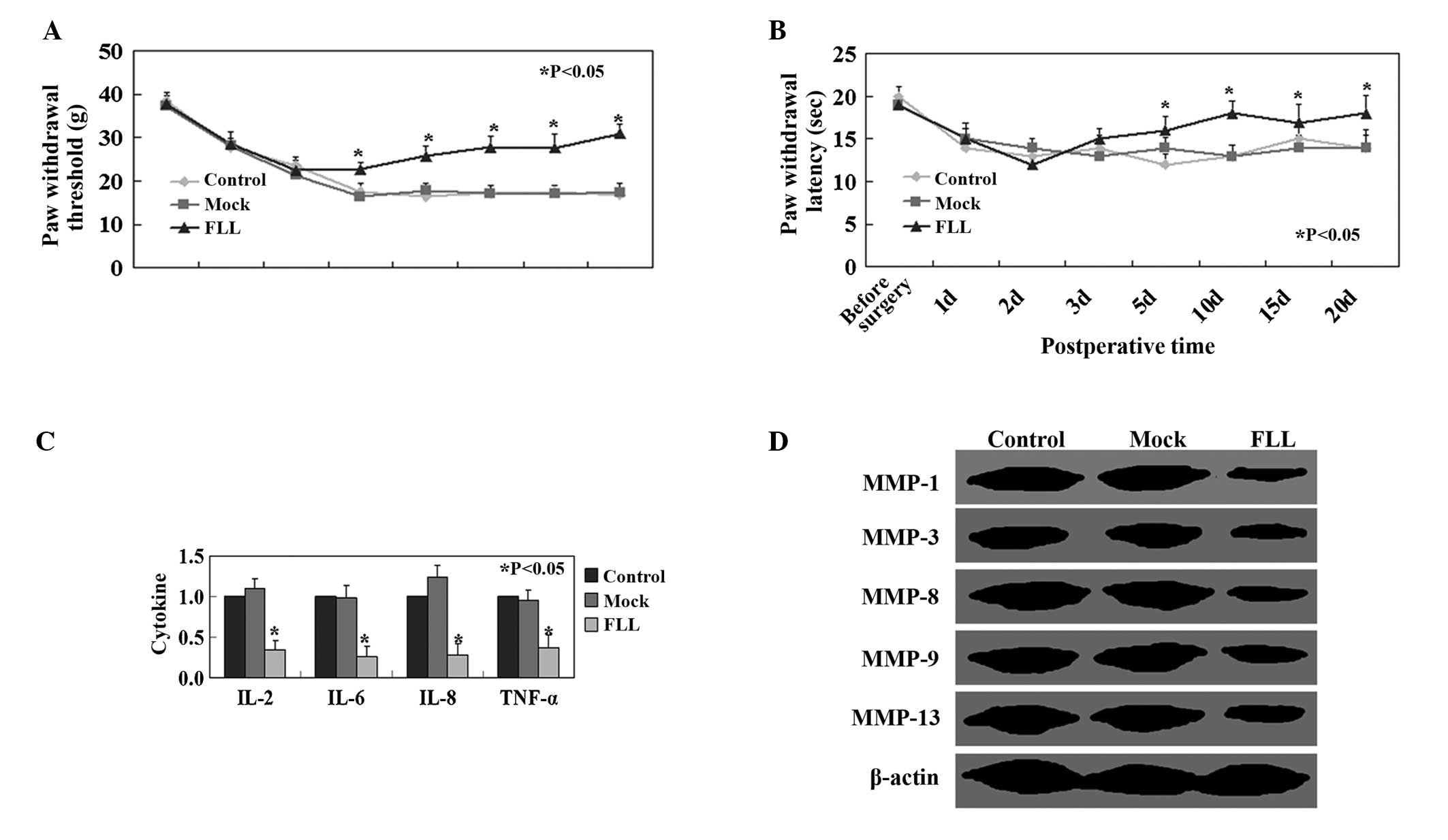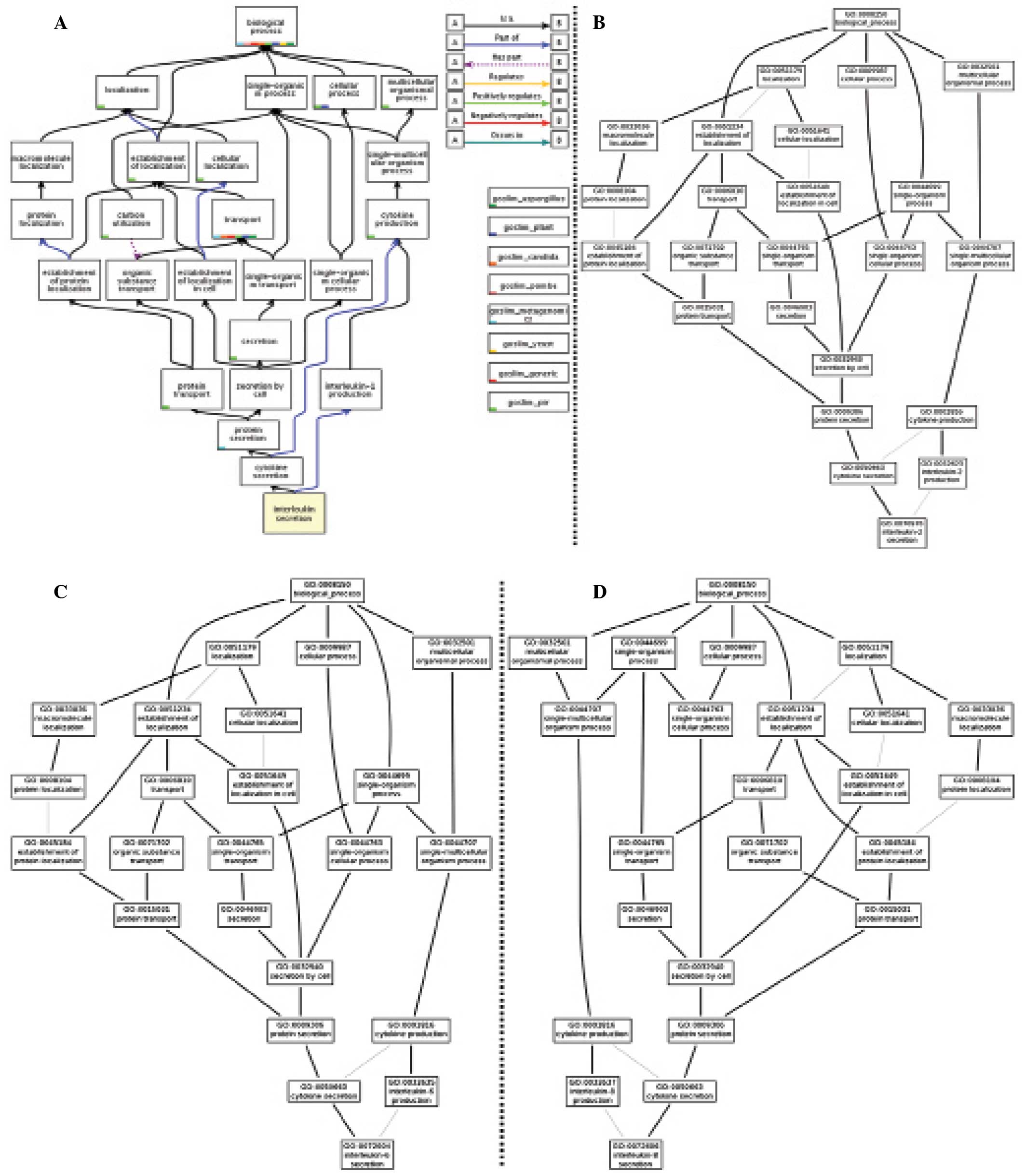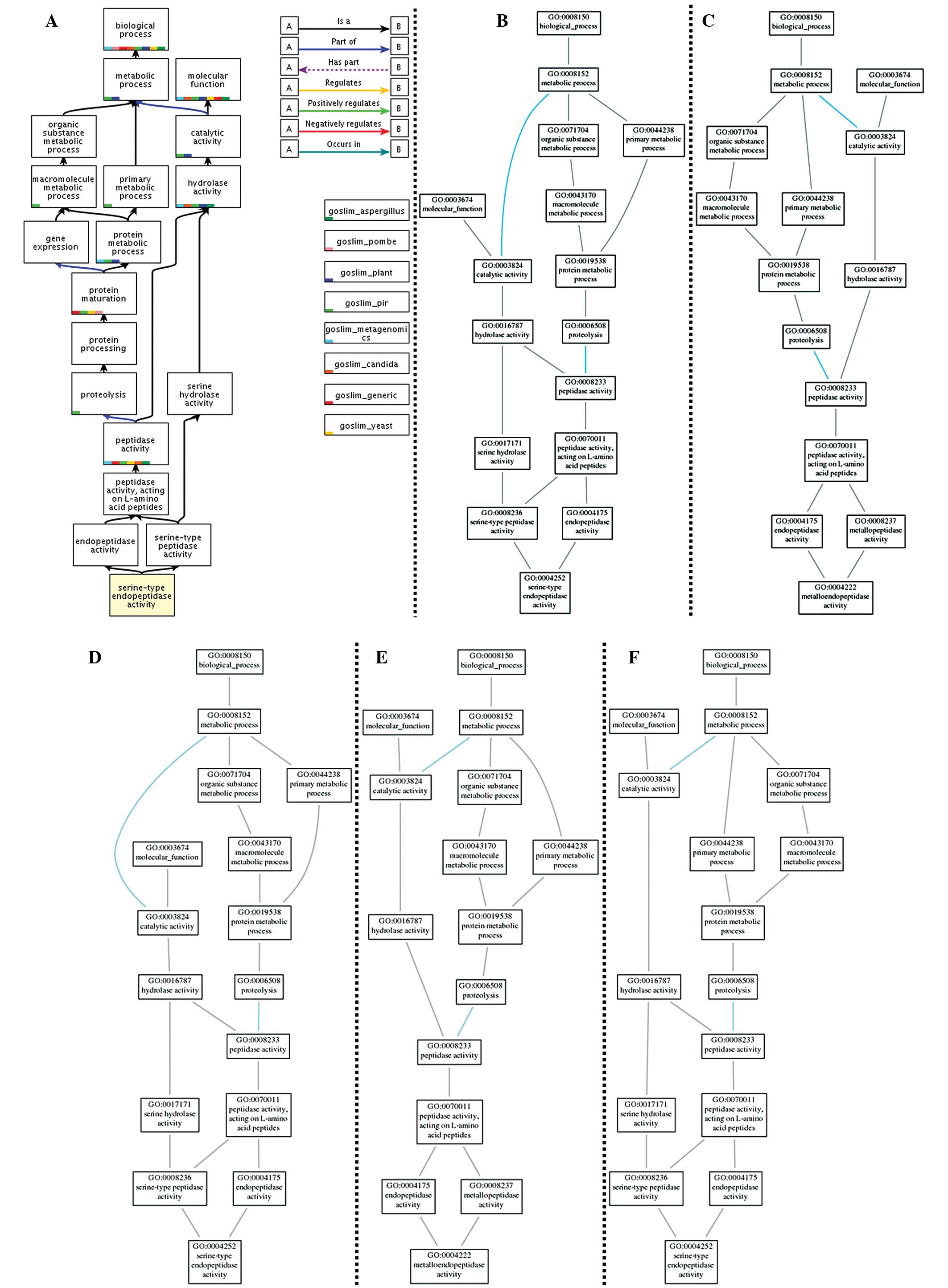Comparative analysis of the influence of Fructus Ligustri Lucidi on a rat lumbar disc herniation model
- Authors:
- Published online on: March 24, 2015 https://doi.org/10.3892/mmr.2015.3547
- Pages: 1225-1232
Abstract
Introduction
Fructus Ligustri Lucidi (FLL), the vernacular name for the fruit of Ligustrum lucidum, is a herb used for treating age-associated diseases (1). FLL ethanol extract modulates the turnover of bone and the calcium balance in ovariectomized rats (2). FLL may improve the uptake of calcium from the diet, predominantly via its actions on increasing the levels of 1,25-dihydroxyvitamin D3 (1,25(OH)2D3) serum and vitamin D-dependent calcium binding proteins (CaBP) (3).
Lower back pain is one of the most prevalent and costly health problems in developed countries. For example, lower back pain was found to be one of the most expensive diseases in Australia, with an estimated cost in 2001 of $9.17 billion (4). The predominant cause of lower back pain is lumbar disc herniation (LDH). LDH is a term referring to a group of conditions, including back pain, femoral nerve pain and sciatica. LDH may be caused by the compression of dural or spinal nerve roots, associated with rupturing of the annulus fibrosus or by a herniated nucleus forcing pressure on the spinal canal (5). Current treatments and surgeries for patients with LDH include conventional open discectomy, microdiscectomy, percutaneous laser discectomy, percutaneous discectomy and microendoscopic discectomy (6). Although there are numerous cases with successful outcomes for patients with LDH following disc surgery, there remain a significant number of patients who do not benefit from this procedure (7,8).
To the best of our knowledge, little is known as to whether FLL may improve the prognosis for patients with LDH following disc surgery. In the present study, the efficacy of FLL to reduce pain was evaluated using a lumbar disc herniation rat model.
Materials and methods
Tissue samples
Intervertebral disc tissue samples were collected from 51 patients who had undergone posterior open discectomy for LDH in the Department of Orthopedics (The First Affiliated Hospital of China Medical University, Shenyang, China) between May 2010 and May 2013. Five cadaveric tissue samples were also obtained from cancer patients within 36 h of mortality with no previously known spinal pathology. Blood samples from the patients with LDH and 20 healthy volunteers were collected in ethylenediamine tetraacetic acid on ice. Samples were immediately centrifuged at 3,000 × g for 20 min. Plasma samples were frozen at −70°C. Patients or relatives signed an informed consent form approved by the China Medical University ethics committee prior to participation in the study. The study design was in accordance with the Declaration of Helsinki. Patient and control group data are provided in Table I.
Cytokine assay
Enzyme-linked immunosorbent assay (ELISA) kits for inflammatory cytokines: Interleukin-2 (IL-2), IL-6, IL-8 and tumor necrosis factor-α (TNF-α) were purchased from R&D Systems, Inc. (Minneapolis, MN, USA). ELISA was conducted according to the manufacturer’s instructions. Cytokine levels were expressed as pg/ml of sample homogenate.
Preparation of FLL extract
Ligustrum lucidum plants were obtained from Liaoning, China. Dried and powered crude plant material was extracted twice using 70% ethanol. The crude plant was boiled with distilled water twice, each lasting 2 h. The mixture was filtered to collect the filtrate, which was evaporated using a rotary evaporator (rotary evaporator; Shyarong Biochemical Instruments Inc., Shanghai, China) under reduced pressure, yielding 23.5% of the weight of the starting materials.
Operation procedure
The study protocol was approved by the Animal Ethics Committee of China Medical University. Male Sprague-Dawley rats (n=90; weight, 200–250 g; Harlan Sprague Dawley Inc.; Indianapolis, IN, USA) were used in the present study. According to methods described previously by Obata et al, rats were anesthetized using intraperitoneal injection of sodium pentobarbital (40 mg/kg; Beijing Propbs Biotechnology Co., Ltd., Beijing, China) (9). Laminectomies were performed in the left L5 nerve roots and dorsal root ganglions (DRG) were exposed. Nucleus pulposuses, harvested from the second and third coccygeal intervertebral discs, were implanted next to the left L5 nerve roots, near to the DRG.
Treatment groups
Rats were separated into three groups: Control group, normal diet; mock group, normal diet mixed with ethanol (200 mg/kg) and FLL group, normal diet mixed with FLL extract (200 mg/kg). Rats were provided with sterile deionized water, ad libitum.
Evaluation of mechanical allodynia and thermal hyperalgesia
Evaluations were performed prior to surgery (day 0) and on days 5, 10, 15, 20, 25 and 30 after surgery.
Mechanical allodynia was evaluated by measuring the withdrawal response of the hind paw to a mechanical stimulation, using a Von Frey assay (North Coast Medical, Inc., Gilroy, CA, USA) that had been calibrated to the force required to elicit a withdrawal response (g) (10). Rats were placed in a clear plastic cage with a metal mesh floor and allowed to acclimatize to the testing environment for 15 min. The plantar surface of each hind paw was stimulated five times using Von Frey filaments, beginning with a 0.1 g filament, the thickness was increased or decreased, until a withdrawal response was observed in three of the five stimuli. Filaments were increased every 6–8 mins with logarithmically incremental rigidity of 0.41, 0.70, 1.20, 2.00, 3.63, 5.50, 8.50 and 15.1 g, to calculate the mechanical threshold. Fifty percent probability thresholds of mechanical paw withdrawal were calculated. If no withdrawal response of the hind paw was observed prior to stimulation with a 26-g filament, 26 g was assigned as the mechanical threshold.
Thermal hyperalgesia was determined by measuring paw withdrawal latency in a thermal stimulation system (XR1102; Shanghai Xin Ruan Information Technology Co., Ltd., Shanghai, China) consisting of a clear plastic chamber (10 × 20 × 24 cm) on a clear smooth glass floor, at 30°C. Rats were placed individually in the chamber for ~15 min, in order to acclimatize to the chamber conditions. A heat stimulus (150 mcal/sec/cm2) was delivered using a 0.5-cm diameter radiant heat source positioned under the plantar surface of the paw. Once a rat withdrew its paw from the heat stimulus, a photocell detected the interruption of a light beam, which automatically switched off the infrared generator and stopped the timer, providing the value for paw withdrawal latency. This method exhibits a 0.1 sec precision level for the measurement of paw withdrawal latency. If a rat failed to withdraw its paw the heat stimulus was automatically discontinued after 25 sec.
Reverse transcription-quantitative polymerase chain reaction (RT-qPCR)
Total tissue RNA was isolated using TRIzol® reagent (Invitrogen Life Technologies, Carlsbad, CA, USA) and was reverse transcribed using SuperScript II reverse transcriptase (Invitrogen Life Technologies) according to the manufacturer’s instructions. RT-qPCR analysis was performed using an ABI prism 7500 sequence detection system (Applied Biosystems Life Technologies, Foster, CA, USA) and an SYBR Green PCR Master mixture (Takara Biotechnology Co., Ltd., Dalian, China). Primer sequences are shown in Table II. PCR conditions were as follows: One cycle at 95°C for 10 min followed by 40 cycles of 95°C for 15 sec and 60°C for 1 min. Relative quantification was calculated by the ΔΔCt method using High Resolution Melt v.2.0 software from Applied Biosystems Life Technologies.
Western blotting
Specimens from the patients and the mouse model were lysed using a lysis buffer (50 mM Tris-HCl, pH 7.4; 150 mM NaCl, 1% Triton X-100, 0.1% sodium dodecyl sulfate, 1 mM ethylenediaminetetraacetic acid, 1 mM Na3VO4 and 1 mM NaF, protease inhibitor cocktail). The extracts were incubated on ice for 20 min and centrifuged at 12,000 × g for 20 min at 4°C, and the supernatants were collected. Protein concentrations were determined using a Bradford assay (Bio-Rad Laboratories, Hercules, CA, USA) and proteins were separated using 10% Bis-Tris gel (Bio-Rad Laboratories) electrophoresis, transferred to a nitrocellulose membrane (Bio-Rad Laboratories), and western blot analysis was performed. The primary antibodies are summarized in Table III. The secondary mouse monoclonal antibodies antibodies included anti-mouse IgG (A0216), anti-rabbit IgG (A0239) or anti-goat IgG (A0182; determined by primary antibodies) at a dilution of 1:1,000-2,000 (Amersham Biosciences, Needham, MA, USA). Subsequently, the results were detected by enhanced chemiluminescence (Amersham Pharmacia, Piscataway, NJ, USA).
GeneChip technology
Total RNA was extracted from cells as described above. Total RNA samples were then analyzed using a GeneChip assay (Affymetrix, Inc., Santa Clara, CA, USA). Three replicates were performed for each experimental group. Gene expression analysis was performed using GeneChip (Affymetrix), according to the manufacturer’s instructions. Gene expression analysis was performed using three arrays and three independent mRNA samples for each treatment. Microarray data were analyzed using Bio MAS 3.0 software (CapitalBio Corporation, Beijing, China). A fold change of ≥2 or ≤0.5 and a Q-value of ≤5% were used as cutoff criteria The value of the control group was set as a standard of 1.0 and the value of the other two groups was plotted with respect to the control group. Differentially expressed genes were screened and clustered among the control group, mock group and FLL group using an Affymetrix Rat230.2 array.
Gene ontology (GO) analysis
The associations between gene expression and biological processes, molecular functions, and cellular compartments, were annotated using the GOTree Machine (11). GOTree Machine uses a hypergeometric test to evaluate the significance of gene enrichment for each category by determining whether the observed number of gene counts exceed the expected counts. Results were visualized as a directed acyclic graph in order to demonstrate the relationships among the enriched GO categories.
Statistical analysis
Using GraphPad 5.0 software (GraphPad Software, Inc., La Jolla, CA, USA), data were analyzed using Student’s t-test. P<0.05 was considered to indicate a statistically significant difference.
Results
MMP and inflammatory cytokine levels in healthy and LDH tissues
MMP-1, -3, -8, -9 and -13 protein expression levels were downregulated in healthy tissues compared with those in LDH tissues (P<0.05, Fig. 1A). Transcript levels of MMPs were significantly higher in LDH tissues than in healthy tissues (P<0.05, Fig. 1B). Inflammatory cytokine expression levels were significantly lower in the healthy control group compared with those in the LDH group (Fig. 1C; P<0.05).
Effects of FLL on mechanical allodynia and thermal hyperalgesia
Paralysis was not observed in rats throughout the experiments. Significant attenuation of mechanical allodynia was observed in the FLL-treated group compared with the control and mock groups (P<0.05, Fig. 2A). Mean withdrawal latency in rats in the FLL-treated group was significantly higher than in rats in the control and mock groups (P<0.05, Fig. 2B). IL-2, IL-6, IL-8 and TNF-α expression levels were significantly higher in the control and mock group compared with those in the FLL-treated group (P<0.05; Fig. 2C). Protein expression levels of MMPs in the FLL-treated group were lower than those in the mock and control groups (Fig. 2D).
Affymetrix GeneChip analysis
The expression of 645 rat transcripts was analyzed using the GeneChip Rat Genome array (Affymetrix). The expression of 125 genes was upregulated and that of 345 genes was downregulated in the FLL-treated group compared with the control and mock groups (P<0.05, Fig. 3). A GO analysis was conducted using the GOTree Machine. The GO analysis produced clusters of enriched differentially expressed genes (P<0.01) in three categories: Biological processes, cellular component and molecular function. In the GO terms tree (Figs. 4 and 5) the association and overlap of MMPs and inflammatory cytokines are demonstrated. In total, enriched GO terms were found in 71 subcategories under biological process, 16 subcategories under cellular component and 51 subcategories under molecular function. In biological process ontology, the results indicated that cytokine production, cellar localization, protein secretion are predominantly associated with FLL treatment.
Discussion
In the present study, downregulation of the protein expression of MMPs and upregulation of IL-2, IL-6, IL-8 and TNF-α expression was observed in the patients with LDH compared with that in control group. Weiler et al (12) demonstrated a significant correlation between MMP protein activity and histological signs of degeneration in patients with LDH. Similarly, Tsarouhas et al (13) found higher MMP mRNA levels in invertebral disc herniation samples compared with samples from other disc disorders and control specimens. A previous study has demonstrated that inflammatory cytokines are produced by infiltrating mononuclear cells after the onset of disc herniation (14). Consistent with previous studies, increased levels of inflammatory cytokines were observed in the serum of patients with LDH compared with the control group.
Furthermore, the present study demonstrated that FLL ethanol extract may be used for the treatment of LDH. An et al (15) found that FLL treatment reduced inflammation via inhibition of nuclear factor-κB in mouse peritoneal macrophages. The results of the present study also demonstrated that daily FLL ethanol extract treatment decreased the levels of inflammatory cytokines in serum in rats with LDH. Previous studies have also demonstrated that FLL promotes bone development with increased mineral density and improved bone mechanical properties (16,17). It is hypothesized that bone development in response to FLL treatment may benefit LDH treatment. However, the mechanisms underlying these processes require further investigation.
Gene expression profiling and GO analysis were conducted in order to explore the changes of mRNA expression in the FLL-treated group. No changes among associated genes were observed. However, the results of the GO analyses suggested that FLL may be associated with a number of biological processes, including cytokine production and secretion, cellular components, including the proteasome, and molecular functions, including proteolysis. GO terms for cytokine secretion and cytokine production were highly enriched in the FLL treated group. Therefore, we focused further on cytokine secretion, which were induced by FLL. The limitation of this method is conventional gene expression signatures are simpler as it requires less transformation of the data. Therefore, the mechanistic meaning of their co-regulation remains difficult to interpret.
In conclusion, the present study was the first to demonstrate the potential of FLL treatment for LDH. The pharmacological effects and active ingredients of FLL should be investigated in future studies.
Acknowledgments
The authors would like to thank Dr Yu-Min Sun for technical assistance.
References
|
Li ML: Progress in the study on fructus Ligustri lucidi. Zhongguo Zhong Yao Za Zhi. 19:504–506. 1994.In Chinese. PubMed/NCBI | |
|
Zhang Y, Lai WP, Leung PC, Wu CF, Yao XS and Wong MS: Effects of Fructus Ligustri Lucidi extract on bone turnover and calcium balance in ovariectomized rats. Biol Pharm Bull. 29:291–296. 2006. View Article : Google Scholar : PubMed/NCBI | |
|
Zhang Y, Lai WP, Leung PC, Che CT and Wong MS: Improvement of Ca balance by Fructus Ligustri Lucidi extract in aged female rats. Osteoporos Int. 19:235–242. 2008. View Article : Google Scholar | |
|
Hoy D, March L, Brooks P, Woolf A, Blyth F, Vos T and Buchbinder R: Measuring the global burden of low back pain. Best Pract Res Clin Rheumatol. 24:155–165. 2010. View Article : Google Scholar : PubMed/NCBI | |
|
Golob AL and Wipf JE: Low back pain. Med Clin North Am. 98:405–428. 2014. View Article : Google Scholar : PubMed/NCBI | |
|
Iwamoto J, Sato Y, Takeda T and Matsumoto H: The return to sports activity after conservative or surgical treatment in athletes with lumbar disc herniation. Am J Phys Med Rehabil. 89:1030–1035. 2010. View Article : Google Scholar : PubMed/NCBI | |
|
Daneyemez M, Sali A, Kahraman S, Beduk A and Seber N: Outcome analyses in 1072 surgically treated lumbar disc herniations. Minim Invasive Neurosurg. 42:63–68. 1999. View Article : Google Scholar : PubMed/NCBI | |
|
Findlay GF, Hall BI, Musa BS, Oliveira MD and Fear SC: A 10-year follow-up of the outcome of lumbar microdiscectomy. Spine (Phila Pa 1976). 23:1168–1171. 1998. View Article : Google Scholar | |
|
Obata K, Tsujino H, Yamanaka H, Yi D, et al: Expression of neurotrophic factors in the dorsal root ganglion in a rat model of lumbar disc herniation. Pain. 99:121–132. 2002. View Article : Google Scholar : PubMed/NCBI | |
|
Sasaki N, Sekiguchi M, Kikuchi S and Konno S: Anti-nociceptive effect of bovine milk-derived lactoferrin in a rat lumbar disc herniation model. Spine (Phila Pa 1976). 35:1663–1667. 2010. View Article : Google Scholar | |
|
Zhang B, Schmoyer D, Kirov S and Snoddy J: GOTree Machine (GOTM): A web-based platform for interpreting sets of interesting genes using Gene Ontology hierarchies. BMC Bioinformatics. 5:162004. View Article : Google Scholar : PubMed/NCBI | |
|
Weiler C, Nerlich AG, Zipperer J, Bachmeier BE and Boos N: 2002 SSE award competition in basic science: Expression of major matrix metalloproteinases is associated with intervertebral disc degradation and resorption. Eur Spine J. 11:308–320. 2002. View Article : Google Scholar : PubMed/NCBI | |
|
Tsarouhas A, Soufla G, Katonis P, Pasku D, Vakis A and Spandidos DA: Transcript levels of major MMPs and ADAMTS-4 in relation to the clinicopathological profile of patients with lumbar disc herniation. Eur Spine J. 20:781–790. 2011. View Article : Google Scholar : | |
|
Yoshida M, Nakamura T, Sei A, Kikuchi T, Takagi K and Matsukawa A: Intervertebral disc cells produce tumor necrosis factor alpha, interleukin-1beta, and monocyte chemoattractant protein-1 immediately after herniation: An experimental study using a new hernia model. Spine (Phila Pa 1976). 30:55–61. 2005. | |
|
An HJ, Jeong HJ, Um JY, Park YJ, Park RK, Kim EC, Na HJ, Shin TY, Kim HM and Hong SH: Fructus Ligustrum lucidi inhibits inflammatory mediator release through inhibition of nuclear factor-kappaB in mouse peritoneal macrophages. J Pharm Pharmacol. 59:1279–1285. 2007. View Article : Google Scholar : PubMed/NCBI | |
|
Feng X, Lyu Y, Wu Z, Fang Y, Xu H, Zhao P, Xu Y and Feng H: Fructus ligustri lucidi ethanol extract improves bone mineral density and properties through modulating calcium absorption-related gene expression in kidney and duodenum of growing rats. Calcif Tissue Int. 94:433–441. 2014. View Article : Google Scholar | |
|
Lyu Y, Feng X, Zhao P, et al: Fructus Ligustri Lucidi (FLL) ethanol extract increases bone mineral density and improves bone properties in growing female rats. J Bone Miner Metab. 32:616–626. 2014. View Article : Google Scholar |














